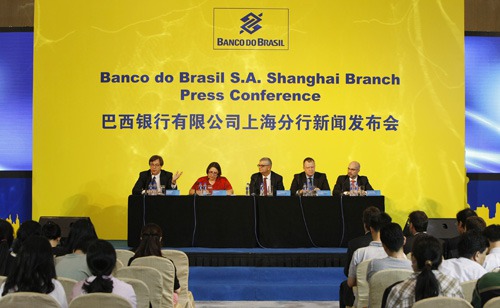|
 |
|
CASH IN: Banco do Brasil launches a comprehensive branch in Shanghai on May 30 (XINHUA) |

Chinese President Xi Jinping's second tour to Latin America in less than two years since taking office underscored the high importance China places on Sino-Latin American relations. The host of advantages in the region—including huge market potential, rich natural resources, a large working-age population, an evolving industrial system, and a relatively stable security situation—have provided a robust environment for Chinese enterprises' overseas investment. Sino-Latin American economic and trade ties have advanced by leaps and bounds in recent years, as the region has already become an indispensable strategic partner for China's foreign economic cooperation.
Complementary economies
China and Latin America have large degree of mutual complementarity in terms of their economic structure and development stages. Latin America is China's most important resources and energy supplier, while China in turn provides electromechanical equipment, electrical appliances and light industry products. At the same time, each party is becoming the other's most promising investment market.
China is the most important consumer of Latin America's agricultural and livestock products, which are major export products in Brazil, Argentina, Chile and Mexico. For example, the annual soybean yield in Brazil is close to 100 million tons; and that of Argentina is more than 40 million tons. Argentina and Brazil's beef, Mexico's pork and Chile's seafood are not only of high quality, but are also voluminous in quantity. Meanwhile, as living standards improve in China, demand for Latin American agricultural and livestock products has soared. China is now the biggest buyer of Brazilian and Argentinean soybeans, as well as the primary prospective market for Latin American meat, fishmeal, fruit, wine and soybean oil. In February, China National Cereals, Oils and Foodstuffs Corp. (COFCO) purchased 51 percent of the Netherlands' Nidera, an agribusiness and trading company which is sourced in some Latin American countries. The partnership will help extend COFCO's global presence and its access to Latin American agricultural products.
Latin America is rich in natural resources. Brazil is the world's largest iron-ore producer and exporter; and it ranks among the top 10 in deep-sea petroleum reserves. Chile is the world's largest producer and exporter of copper. Venezuela and Mexico are both rich in petroleum reserves. In the meantime, China—dubbed the "factory of the world"—requires a stable supply of energy and resources. Thus, China and Latin America must work together more closely in the fields of energy and natural resources. In recent years, oil giants like China National Petroleum Corp., China Petrochemical Corp. and China National Offshore Oil Corp. have expanded their presence in the Latin American energy industry by becoming shareholders in local oil companies in Brazil, Venezuela, Argentina and Ecuador.
China is also expected to become Latin America's biggest investor in its infrastructure construction. Outdated infrastructure has hindered the ability of Latin American countries to maximize their economic potential. Countries in the region are strengthening local logistics systems and the construction of power plants and oil pipelines. Brazil uses infrastructure investment as a means to tackle economic problems. The country began the reconstruction and expansion of its airports last year, anticipating large air travel during the 2014 World Cup season; more highways, railways and ports will be built or upgraded. Brazil is looking forward to the participation of Chinese enterprises and capital. Meanwhile, Argentina expects Chinese companies to accelerate investment in power generation and transportation, especially its two $4 billion hydropower stations in the south, and a multi-billion-dollar contract for an intercity railway reconstruction and vehicle supply project in its capital. In addition, Latin America integration—which includes more efficient transportation and communication connections—will benefit from greater Chinese investment.
|
